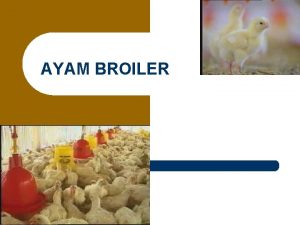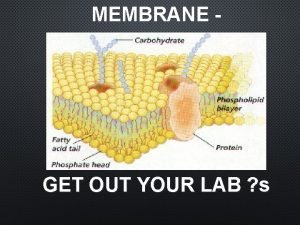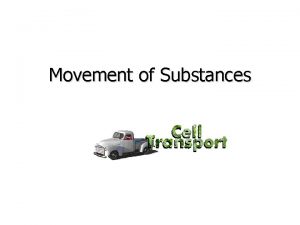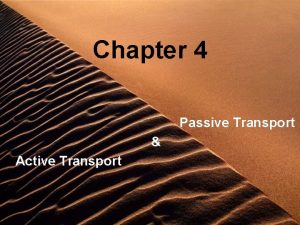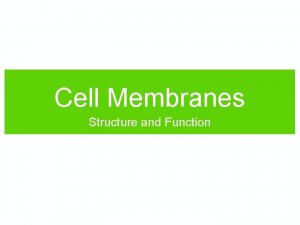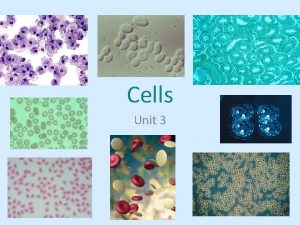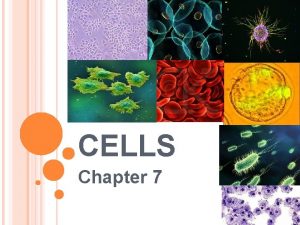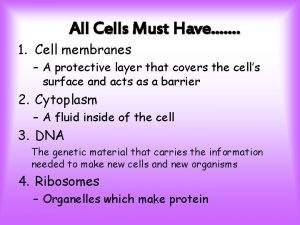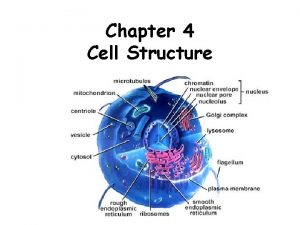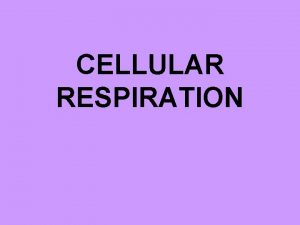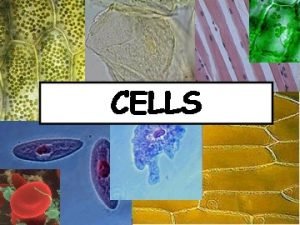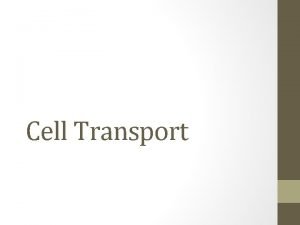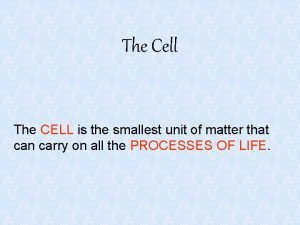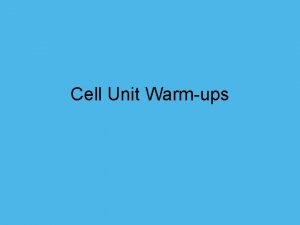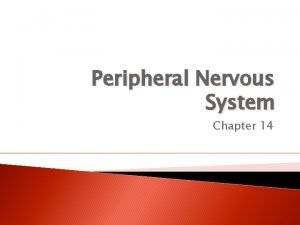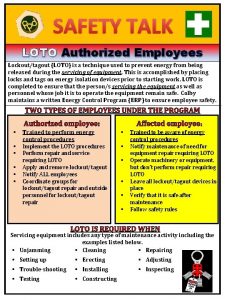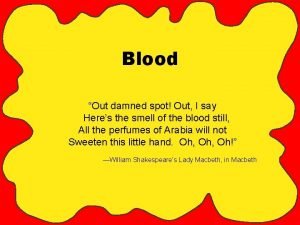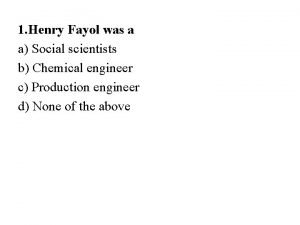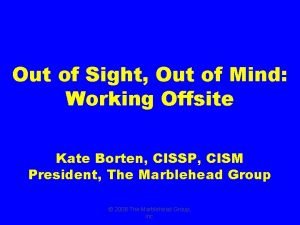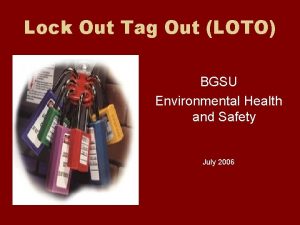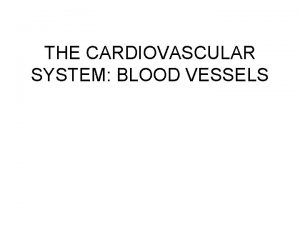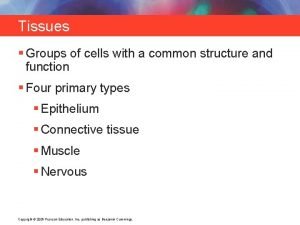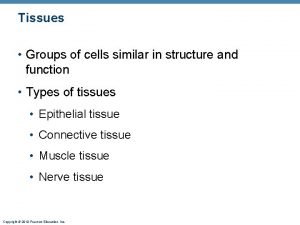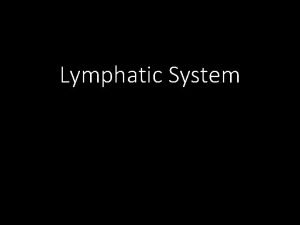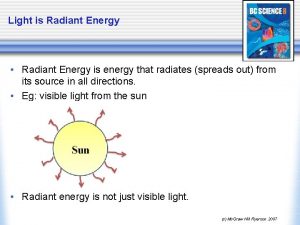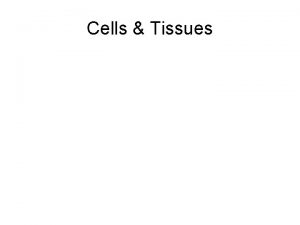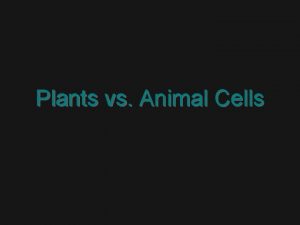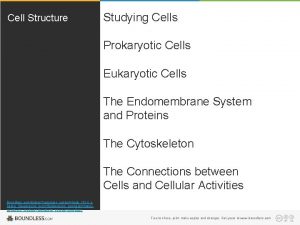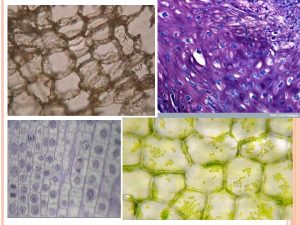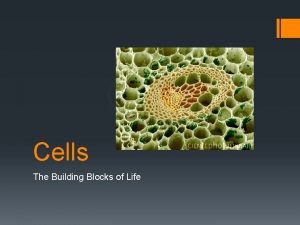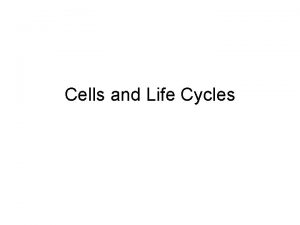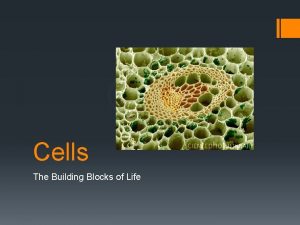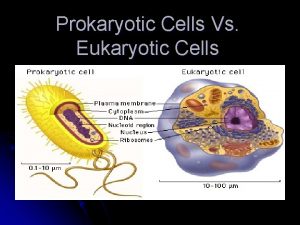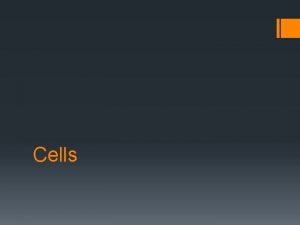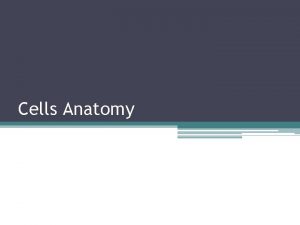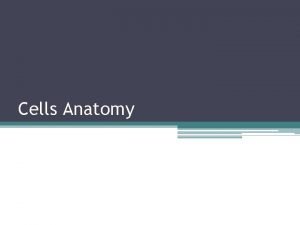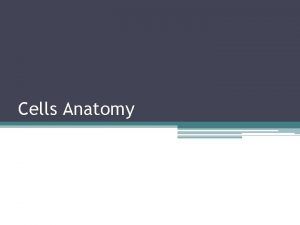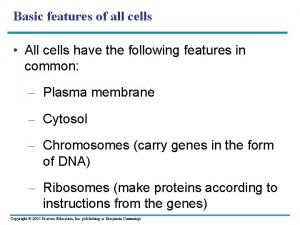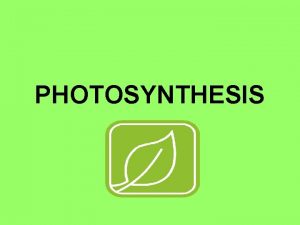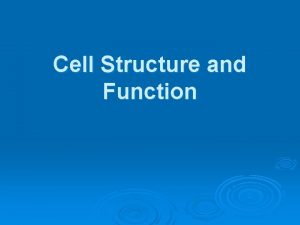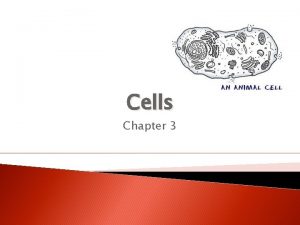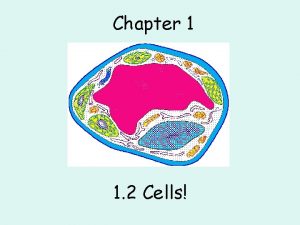Structure of Cells All start out life with





























































- Slides: 61



细胞的结构(Structure of Cells) All start out life with: –细胞膜(Plasma membrane, encircling a region where DNA is stored) –细胞质(Cytoplasm) Two types: –原核(Prokaryotic) –真核(Eukaryotic)


动物细胞(Animal Cells) • • • 质膜Plasma membrane 细胞核Nucleus 核糖体Ribosomes 内质网Endoplasmic reticulum 高尔基体Golgi body 小泡Vesicles 线粒体Mitochondria 溶酶体Lysosome 细胞骨架Cytoskeleton 中心体 Centrosome

植物细胞(Plant Cells) • • • 质膜Plasma membrane 细胞核Nucleus 核糖体Ribosomes 内质网Endoplasmic reticulum 高尔基体Golgi body 小泡Vesicles 线粒体Mitochondria 溶酶体Lysosome 细胞骨架Cytoskeleton • 细胞壁Cell wall • 中央液泡Central vacuole • 叶绿体Chloroplast

细胞核(Nucleus)

8 G 0和G 1期染色体: 染色质(Chromosomes at G 1 phase: Chromatin) 30 nm Coding (blue) and non-coding strands (grey) of DNA 2 nm G 0和G 1期细胞中染 色体通常存在的状 态(The “usual” state of chromosomes in G 0 and G 1 cells)

9 S-G 2期染色体: 染色质(Chromosomes at SG 2 phase: Chromatin) G 2期细胞中染色体通 常存在的状态(The “usual” state of chromosomes in G 2 cells (after DNA replication) Special DNA binding proteins e. g. cohesins “Old” coding strand “New” coding strand 两个G 1期染色质的并排排列,之间有cohesins蛋白连接

10 前期染色体(Chromosomes at prophase) “Old” coding strand “New” coding strand Mitotic Chromosome When cells entry mitosis: Chromatin condense together into a mitotic chromosome

11 The mechanism of chromosome condensation is not completely understood but note… Condensin complex P Phosphorylation of histones & proteins in condensin complex P

DNA package and chromosome condensation with cell cycle progression from G 2 to metaphase

Human T-lymphocyte metaphase Karyotype 46, XY

中期染色体(Chromosomes at Metaphase) 5 um

着丝粒 Centromeres the largest constriction of the chromosome. 100, 000 s of 171 base pair repeat, called alpha satellite sequences Centromere associated proteins are bound: Kinetochore Site of attachment of spindle fibers

Centromere and Kinetochore

端粒 Telomeres At the tips of chromosomes: Protect Many repeats of the sequence TTAGGG Subtelomeres have more varied short repeats

荧光原位杂交检测染色体的完整性 Human N-Tert 1 cells have intact chromosomes detected by FISH using telomeric and centromeric probes Qinghua Shi unpublished 人类全着丝粒探针 (pan-centromeric,Green) 和全端粒探针 (pan-telomeric, Red)



染色体 The Chromosomes • 染色体在体细胞中成对出现 Chromosomes occurs in pairs in every somatic cell except in the sperm and ovum. • 一个物种的绝大多数(全部)体细胞,其染 色体数目相同Chromosomes numbers are the same in vast majority (every) somatic cell for each species.

染色体 The Chromosomes • 在二倍体细胞中含 2条性染色体 There are 2 sex chromosomes included in the diploid number of the chromosomes. • 除性染色体以外的染色体统称为常染色体 All of the other chromosomes are referred to as autosomes. • 雌性哺乳类的2条性染色体相同 In mammals if the sex chromosomes are alike, XX it results in a female. • 雄性哺乳类的2条性染色体不同 If the sex chromosomes are different, XY it results in a male. (例外:毛冠鹿)

染色体传递:细胞分裂 Chromosome transmitting: Cell Division • Meiosis 减数分裂 –Is the form of cell division which results reduce the chromosome number from the diploid # to the haploid #. –Occurs only in the sex cells, generate sperm and egg. • Mitosis 有丝分裂 –Is the form of cell division which results in the formation of identical daughter cells, keeps the chromosome number constant. –Tissue growth and repair. –Occurs throughout the body except in the sex cells.

正常有丝分裂 绿色荧光蛋白( Green fluorescence protein, GFP)-组 蛋白H 2 B融合基因, 转入细胞中,使其 表达 Shi & King, Nature 437: 10381042, 2005 Abscission

细胞周期示意图 Cell Cycle Progression Shi, unpublished S G 1 Checkpoint G 2 Checkpoint G 1 Prophase A mechanism responds to chromosome missegregation? Telophase 贝班 Anaphase Metaphase Spindle checkpoint

细胞周期 The Cell Cycle • 是一个细胞从其形成到其分裂为 2个细胞的一系列 按序发生的事件 The cell cycle is an orderly sequence of events that occurs from the time when a cell is first formed until it divides into two new cells. • Most of the cell cycle is spent in interphase(G 1, S 和G 2〕. • Following interphase, the mitotic stage of cell division occurs. Division (前、中、后、 末期和细胞质分裂〕

G 2

Early Prophase *Chromosomes condense *Nuclear envelope disappears *Centrioles move to opposite sides of the cell

Late Prophase Spindle forms and attaches to kinetochores on the chromosomes

Metaphase *Chromosomes lined up on equator of spindle *Centrioles at opposite ends of cell

Anaphase *Centromeres divide: each 2 chromatid chromosome becomes two 1 -chromatid chromosomes *Chromosomes pulled to opposite poles by the spindle

Telophase * Chromosomes decondense * Nuclear envelope reappears * Cytoplasm divided into 2 cells

Cytokinesis in Animal Cells • In animal cells, a cleavage furrow begins at the end of anaphase. • A band of actin and myosin filaments, called the contractile ring, slowly forms a constriction between the two daughter cells. • A narrow bridge between the two cells is apparent during telophase, then the contractile ring completes the division.

Cytokinesis in animal cells

Mitosis in Detail • During mitosis, the spindle distributes the chromosomes to each daughter cell. • The spindle contains fibers made of microtubules that disassemble and assemble. • Centrosomes, that duplicate and separate during interphase, organize the spindle. • Centrosomes contain centrioles and asters. • Mitosis has four phases: prophase, metaphase, and telophase.

Mitosis: Maintaining Chromosome Number

Meiosis: Halving chromosome number

Meiosis: Two Divisions • Two consecutive nuclear divisions – Meiosis II • DNA is NOT duplicated between divisions • Four haploid nuclei are formed

Stages of Meiosis II • Prophase II • Metaphase II • Anaphase II • Telophase II

Chromosome behavior in meiosis I prophase



Meiosis I - Stages Crossing over Prophase I Random alignment of chromosomes at metaphase I Homologues separate Metaphase I Anaphase I Telophase I

Sister chromatids separate

精子发生 Spermatogenesis spermatogonium (diploid male reproductive cell) primary spermatocyte (diploid) Growth Mitosis I, Cytoplasmic division secondary spermatocytes (haploid) spermatids (haploid) Meiosis II, Cytoplasmic division

卵子发生Oogenesis 第一极体 (n) first polar body (haploid) 卵原细胞 (2 n) oogonium (diploid reproductive cell) Growth 初级卵母细胞 (2 n) primary oocyte (diploid) Meiosis I, Cytoplasmic division 次级卵母细胞 (n) secondary oocyte (haploid) 三个极体(n) 3 polar bodies (haploid) 卵子(n) ovum (haploid) Meiosis II, Cytoplasmic division

人类生命周期 Life cycle of humans

受精 Fertilization • 雌雄配子结合、细胞核融合 Male and female gametes unite and nuclei fuse • 两个单倍体的配子融合形成二倍体的合子 Fusion of two haploid nuclei produces diploid nucleus in the zygote • 配子融合是随机的 That two gametes unite is random –增加了子代的变异 Adds to variation among offspring

导致子代变异的因素 Factors Contributing to Variation Among Offspring • 前期I同源染色体间的交换 (Crossing over during prophase I〕 • 中期I染色体在赤道板上的自由排列 (Random alignment of chromosomes at metaphase I〕 • 配子的自由组合 (Random combination of gametes at fertilization〕

有 丝 分 裂 和 减 数 分 裂 比 较 MITOSIS MEIOSIS Occurs in most types of eukaryotic cells. Occurs in formation of gametes in eukaryotic cells

有 丝 分 裂 和 减 数 分 裂 比 较 MITOSIS MEIOSIS No pairing of Homologous chromosomes pair & synapsis; crossing over may occur

有 丝 分 裂 和 减 数 分 裂 比 较 MITOSIS MEIOSIS Chromosome number is maintained. Chromosome number is reduced from diploidy to haploidy.

有 丝 分 裂 和 减 数 分 裂 比 较 MITOSIS MEIOSIS One division Two divisions

有 丝 分 裂 和 减 数 分 裂 比 较 MITOSIS MEIOSIS Two daughter cells are produced. Four daughter cells are produced.

有 丝 分 裂 和 减 数 分 裂 比 较 MITOSIS MEIOSIS Daughter cells are identical to each other and to parent cell Daughter cells contain varying combinations of chromosomes

有 丝 分 裂 和 • 减 数 分 • 裂 • 比 较 Mitosis & Meiosis Compared Mitosis Functions – Asexual reproduction – Growth, repair Meiosis • Function – Sexual reproduction Occurs in somatic cells • Occurs in germ cells Produces clones • Produces variable offspring

有 前期 (Prophase vs. Prophase I) 丝 分 裂 • 有丝分裂前期 (Prophase, Mitosis) 和 –同源染色体互不影响 (Homologous pairs do 减 not interact with each other. ) 数 分 • 减数分裂前期I (Prophase I, Meiosis) 裂 比 –同源染色体配对、联会、遗传物质交换( 较 Homologous pairs become zippered together and crossing over occurs. )

分裂后期 有 丝 • 分 裂 和 减 数 • 分 裂 比 较 减数分裂后期I (Anaphase I, Meiosis) –同源染色体分开(Homologous chromosomes are separated from each other. ) 有丝分裂后期/减数分裂后期II (Anaphase/Anaphase II, Mitosis/Meiosis) –姐妹染色单体分开 (Sister chromatids of a chromosome are separated from each other)

有 丝 分 裂 • 和 减 数 分 裂 • 比 较 分裂结果(Results of Mitosis and Meiosis) 有丝分裂 (Mitosis) – 2个二倍体细胞 (Two diploid cells produced) – 2个子细胞均与亲代细胞相同 (Each identical to parent) 减数分裂 (Meiosis) – 4个单倍体细胞 (Four haploid cells produced) – 4个子细胞互不相同, 且有别于亲代细胞 (Differ from parent and one another)

生命的细胞理论(1) 1) 每种生物都是由 1个或多个细胞组成的 (Every organism is consisted of one or more cells) 2) 细胞是生命的最小单位(Cell is smallest unit of life) 3) 生命的延续是以单个细胞的生长和分裂为基础的 (Continuity of life arises from growth and division of single cells)

生命的细胞理论(2) 4〕可独自生存或具此潜力 Can survive on its own or has potential to do so 5〕可进行高度有序的代谢 Is highly organized for metabolism 6〕可感受并对环境的变化作出反应 Senses and responds to environment 7〕具有增殖的潜力 Has potential to reproduce
 One direction metaphors
One direction metaphors Sistem all in all out
Sistem all in all out Olfactory groove keros classification
Olfactory groove keros classification Regulation of tubular reabsorption
Regulation of tubular reabsorption Pineal gland
Pineal gland Gametic cells vs somatic cells
Gametic cells vs somatic cells Why dna is more stable than rna?
Why dna is more stable than rna? Chlorocruorin
Chlorocruorin Eukaryotic vs prokaryotic cells
Eukaryotic vs prokaryotic cells Venn diagram for animal and plant cells
Venn diagram for animal and plant cells Prokaryotic vs eukaryotic cells venn diagram
Prokaryotic vs eukaryotic cells venn diagram Cell organelle jeopardy
Cell organelle jeopardy Masses of cells form and steal nutrients from healthy cells
Masses of cells form and steal nutrients from healthy cells Pseudostratified vs simple columnar
Pseudostratified vs simple columnar 4 types of eukaryotic cells
4 types of eukaryotic cells Prokaryotic cells vs eukaryotic cells
Prokaryotic cells vs eukaryotic cells Chapter 8 cellular reproduction cells from cells
Chapter 8 cellular reproduction cells from cells Cells and life lesson 1 answer key
Cells and life lesson 1 answer key What cells need isotonic solutions to be at homeostasis
What cells need isotonic solutions to be at homeostasis Site:slidetodoc.com
Site:slidetodoc.com Jumpstart triage algorithm
Jumpstart triage algorithm Name three line segments
Name three line segments The movement in and out of cells
The movement in and out of cells The movement in and out of cells
The movement in and out of cells The movement in and out of cells
The movement in and out of cells What biomolecule transports substances in and out of cells
What biomolecule transports substances in and out of cells Cell transport
Cell transport Cell tissue organ organ system organism
Cell tissue organ organ system organism All cells have
All cells have All cells must contain
All cells must contain All cells exhibit basic structural similarities
All cells exhibit basic structural similarities All cells must contain
All cells must contain The smallest unit of life is the
The smallest unit of life is the Cells are the smallest unit of life
Cells are the smallest unit of life Cells and life lesson 1 answer key
Cells and life lesson 1 answer key A cell is the smallest unit of life
A cell is the smallest unit of life Cells are the basic unit of life true or false
Cells are the basic unit of life true or false Start of a new life
Start of a new life Put out the light and then put out the light
Put out the light and then put out the light Stove-length sticks of wood
Stove-length sticks of wood Outta sight outta mind quotes
Outta sight outta mind quotes Personification in mending wall
Personification in mending wall Lock out tag out safety talk
Lock out tag out safety talk Out out robert frost annotations
Out out robert frost annotations Time
Time Matthew 11:28 the message
Matthew 11:28 the message Lock out tag out pictures
Lock out tag out pictures Out, damned spot! out, i say!
Out, damned spot! out, i say! Find out the odd one out
Find out the odd one out Makna out of sight out of mind
Makna out of sight out of mind Log out tag out deutsch
Log out tag out deutsch Blood
Blood Muscle tissue parts
Muscle tissue parts Dense regular connective
Dense regular connective Tissues are groups of similar cells working together to:
Tissues are groups of similar cells working together to: A saclike structure in which cells store materials
A saclike structure in which cells store materials Short tube that receives purified lymph
Short tube that receives purified lymph Im all out of money gif
Im all out of money gif What is radiant energy examples
What is radiant energy examples All scripture is breathed out by god
All scripture is breathed out by god All scripture is breathed out by god
All scripture is breathed out by god I have measured out my life
I have measured out my life

